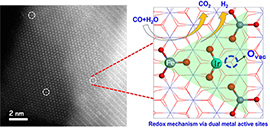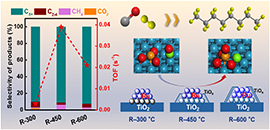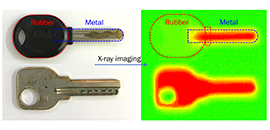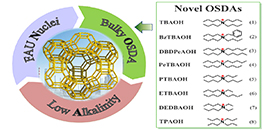Research News
-
 07 01, 2020Scientists Propose Redox Mechanism by Dual Metal Active Sites of Ir1/FeOx for Water‐Gas Shift ReactionScientists from DICP proposed a redox mechanism with synergetic dual metal active sites for the WGS reaction on a Ir1/FeOx SAC.
07 01, 2020Scientists Propose Redox Mechanism by Dual Metal Active Sites of Ir1/FeOx for Water‐Gas Shift ReactionScientists from DICP proposed a redox mechanism with synergetic dual metal active sites for the WGS reaction on a Ir1/FeOx SAC.
The water‐gas shift (WGS) reaction (CO+H2O→CO2+H2) is critical in producing high‐purity hydrogen for ammonia and methanol synthesis as well as in fuel cell applications.
By the concept of single‐atom catalysts (SAC), scientists now can understand the chemical bond and electronic structure between metal and support in an atomic scale.
A research group led by Prof. WANG Xiaodong and Prof. ZHANG Tao from the Dalian Institute of Chemical Physics (DICP) of the Chinese Academy of Sciences (CAS), in collaboration with Prof. LI Jun from Tsinghua University, proposed a redox mechanism with synergetic dual metal active sites for the WGS reaction on an Ir1/FeOx SAC.
The results were published in Angew. Chem. Int. Ed.
The scientists reported a combined theoretical and experimental study on SAC of Ir1/FeOx for WGS reaction. They found that water easily dissociated to OH* on the Ir1 single atom and H* on the nearby O atom bonded with a Fe site. The adsorbed CO on Ir1 reacts with the adjacent O atom to produce CO2. Then, the formation of H2 became feasible due to migration of H from adsorbed OH* toward Ir1 and its subsequent reaction with another H*.
They proposed a new pathway of a redox mechanism via synergetic dual metal active sites between Ir1 and Fe species (DMAS) during the WGS reaction, which demonstrated the sequential production of CO2 and H2.
The elucidation of the catalytic mechanism involving this kind of dual metal active sites might provide insights for understanding the catalytic mechanism of metal catalysts with reducible supports, thus helping rational design of new and active dual-site single-atom and single-cluster catalysts.
This work was supported by the National Natural Science Foundation of China, the Youth Innovation Promotion Association of CAS. (Text by LIN Jian)
Synergetic dual metal active sites of Ir1/FeOx SAC for WGS reaction (Image by LIN Jian) -
 06 30, 2020Strong Metal–support Interaction Directly Involves in CO Dissociation in Fischer–Tropsch SynthesisScientists from DICP developed highly efficient Ru/TiO2 nanocatalyst for FTS, and discovered that the TiOx overlayer at Ru/TiO2 interface directly involves in the catalytic mechanism of FTS to facilitate the CO bond dissociation.
06 30, 2020Strong Metal–support Interaction Directly Involves in CO Dissociation in Fischer–Tropsch SynthesisScientists from DICP developed highly efficient Ru/TiO2 nanocatalyst for FTS, and discovered that the TiOx overlayer at Ru/TiO2 interface directly involves in the catalytic mechanism of FTS to facilitate the CO bond dissociation.
Fischer–Tropsch synthesis (FTS) offers a powerful way to realize the transformation of nonpetroleum resources to syngas and further to high value-added chemicals and fuels.
Late transition metals like Fe, Co and Ru are widely used to facilitate this process. Ru is identified to be intrinsic of high activity and selectivity in FTS. Due to the high price of Ru, there is an urgent need to develop highly efficient Ru-based catalysts with high dispersion.
The utilization of strong metal–support interaction (SMSI) has been demonstrated to be an alternative strategy to enhance the catalytic reactivity of metal catalysts in FTS, while the catalytic role of the metal–support interface remains unclear.
Recently, a group led by Prof. HUANG Yanqiang and Prof. ZHANG Tao from the Dalian Institute of Chemical Physics (DICP) of the Chinese Academy of Sciences developed highly efficient Ru/TiO2 nanocatalyst for FTS, and discovered that the TiOx overlayer at Ru/TiO2 interface directly involves in the catalytic mechanism of FTS to facilitate the CO bond dissociation.
Catalytic performance and structural evolution of the Ru/TiO2 at different stages of reduction (Image by ZHANG Yaru)
Benefiting from the lattice matching of RuO2 and rutile TiO2, the highly dispersed Ru/TiO2 nanocatalyst with an average diameter of approximately 2 nm could be facilely acquired. The small sized Ru nanoparticles (NPs) manifest sintering resistance even under 600°C reduction treatment.
The researchers found that by varying the reduction condition to regulate the TiOx overlayer on the Ru NPs, the catalytic activity of the Ru/TiO2 nanocatalyst in FTS could be boosted, which was superior to other Ru-based catalysts reported previously.
With various characterizations and theoretical modeling, the reduced TiOx overlayer on Ru/TiO2 nanocatalyst wass demonstrated to participate in and dramatically facilitate the bond cleavage of CO.
This study provides a deep insight on the mechanism of TiOx overlayer in FTS, and offers an effective approach to tuning catalytic reactivity of metal nanocatalysts on reducible oxides.
The study was published in Nature Communications on June 24.
This work was supported by the National Key R&D Program of China, the National Natural Science Foundation of China, and the Strategic Priority Research Program of the Chinese Academy of Sciences. (Text by ZHANG Yaru) -
 06 29, 2020Scientists Propose a Pseudotargeted Metabolomics ProtocolScientists proposed a protocol by systematically summarizing and upgrading the pseudotargeted metabolomics method.
06 29, 2020Scientists Propose a Pseudotargeted Metabolomics ProtocolScientists proposed a protocol by systematically summarizing and upgrading the pseudotargeted metabolomics method.
A research group led by Prof. XU Guowang from the Dalian Institute of Chemical Physics (DICP) of the Chinese Academy of Sciences proposed a protocol by systematically summarizing and upgrading the pseudotargeted metabolomics method.
The study was published in Nature Protocols on June 24.
Metabolomics is the science of studying endogenous metabolites. Ultra-high performance liquid chromatography-mass spectrometry is the most widely used analytical tool.
There are mainly two kinds of analysis strategies: untargeted method and targeted method.
The untargeted method uses high-resolution mass spectrometry (HRMS) to obtain abundant metabolite information, with disadvantages of complex data handling, poor repeatability, and narrow linear range.
The targeted method uses triple quadrupole mass spectrometry (TQMS). Although data quality is improved, only known metabolites can be detected.
Prof. XU’s group firstly proposed the idea of pseudotargeted metabolomics in 2012. Its innovation lies in a quantitative ions selection algorithm. Both known and unknown metabolites in samples can be measured by using the retention time locking gas chromatography-mass spectrometry- selected ions monitoring. It merges the advantages of untargeted and targeted metabolomics methods.
The idea was extended to liquid chromatography-mass spectrometry in 2013. In the subsequent works, XU's group further developed software to automatically select ion-pairs to improve the efficiency of method establishment.
On this basis, in order to increase the number of ion-pairs included in the method and improve metabolite coverage, a pseudotargeted metabolomics method based on the sequential windowed acquisition of all theoretical fragment ion (SWATH) was developed.
In their latest work, in order to further improve the coverage, a pseudotargeted method was developed based on a two-dimensional liquid chromatography-mass spectrometry system with high peak capacity. It can be used to separate and analyze amino acids, bile acids, carnitine, and lysophospholipids, etc.
Pseudotargeted metabolomics method is a new method integrating the advantages of untargeted and targeted metabolomics methods (Image by WANG Ting)
These methods have played an active role in the studies of malignant tumors, diabetes and other metabolic diseases. The pseudotargeted methods and idea have also been used by other laboratories.
At present, high-coverage quantitative/semiquantitative metabolomics methods are receiving more and more attention in different fields of life sciences, and the pseudotargeted method will play an increasingly important role in the future.
Prof. XU’s group has further optimized the development procedures of pseudotargeted metabolomics, upgraded and provided open-accessed software and tools to allow more colleagues to use the pseudotargeted method. (Text by ZHENG Fujian) -
 06 28, 2020Researchers Develop 0D-structured Lead-free Perovskite Single Crystals for X-ray ImagingResearchers from DICP reported their development of the 0D-Structured Lead-Free Perovskite Single Crystals for Highly Sensitive Stable X?ray Imaging。
06 28, 2020Researchers Develop 0D-structured Lead-free Perovskite Single Crystals for X-ray ImagingResearchers from DICP reported their development of the 0D-Structured Lead-Free Perovskite Single Crystals for Highly Sensitive Stable X?ray Imaging。
X-ray detectors are widely used in imaging, security-screening, non-destructive inspection, industrial products and scientific research.
Organic-inorganic lead halide perovskites with low cost and facile preparation process have shown excellent properties in direct X-ray detection. However, the ion migration in perovskite materials accelerates its decomposition, deteriorating device performance, and causing baseline drift and lower imaging resolution.
Recently, a research team led by Prof. LIU Shengzhong from the Dalian Institute of Chemical Physics (DICP) of the Chinese Academy of Sciences, in collaboration with Dr. LIU Yucheng Liu, Dr. XU Zhuo and Dr. YANG Zhou from Shaanxi Normal University, developed 0D-structured lead-free perovskite single crystals for highly sensitive stable X-ray imaging.
They developed an effective strategy to grow superior inch-sized high-quality 0D-structured lead-free (CH3NH3)3Bi2I9 perovskite-like single crystals (MA3Bi2I9 PSCs).
Compared with other perovskite materials, these samples showed significantly lower ion migration, reduced dark current and better environmental stability, which could be used to design and fabricate a new type of 0D-structured lead-free X-ray detector.
The X-ray detectors show high sensitivity and a very low detection limit, a factor of 66 below that required for regular medical diagnostics.
The study showed that, compared with 2D and 3D perovskites, the present 0D structure effectively prevents ion migration, showing the best long-term stability among all perovskites reported.
The combination of large crystal size and excellent X-ray response inspire researchers to design and fabricate the first 0D-structured lead-free MA3Bi2I9 single-crystal X-ray imaging system with reduced X-ray dose and improved resolution.
Their findings were published in Matter. (Text by DUAN Lianjie and LIU Yucheng)
Top: Photographs of typical MA3Bi2I9 SCs and the X-ray sensitivity of the MA3Bi2I9 SC X-ray detector as a function of applied electric field; Below: Photograph and corresponding X-ray images of a metallic key with partially wrapped in rubber and a naked metal key. (Image by DUAN Lianjie and LIU Yucheng) -
 06 28, 2020Scientists Propose New Strategy to Directly Synthesize High Silica Zeolite YScientists from DICP developed a new strategy to realize the direct synthesis of high silica zeolite Y with SiO2/Al2O3 ratio (SAR) as high as 15.6.
06 28, 2020Scientists Propose New Strategy to Directly Synthesize High Silica Zeolite YScientists from DICP developed a new strategy to realize the direct synthesis of high silica zeolite Y with SiO2/Al2O3 ratio (SAR) as high as 15.6.
Fluidized catalytic cracking (FCC) and hydrocracking are the most important processes in the petroleum refining industry. High silica zeolite Y with FAU topology is the main active component for industrial cracking catalysts, which consumption ranks the first in the solid catalysts.
However, the physique of Al-rich framework of zeolite Y brings a fatal drawback in hydrothermal stability toward its practical applications. To alleviate this issue, repeated dealumination processes have been employed in order to achieve the high silica counterparts.
These post-treatment procedures are complicated and time/energy-consuming. Over the past 60 years, the direct synthesis of high silica Y remains a symbolic challenge in the field of zeolite synthesis, with a limited improvement of SiO2/Al2O3 ratio (SAR) from ~5 to 9.
Recently, a group led by Prof. TIAN Peng and Prof. LIU Zhongmin from the Dalian Institute of Chemical Physics (DICP) of the Chinese Academy of Sciences developed a new strategy to directly synthesize high silica zeolite Y with SAR as high as 15.6. The results were published in Adv. Mater.
NOA-co strategy and novel OSDAs for the synthesis of high silica zeolites Y (Image by WANG Linying and ZHU Dali)
The novel strategy, named NOA-co strategy, involved the use of highly dispersed FAU nuclei solution, bulky organic structure directing agent (OSDA) and low alkalinity synthetic gel.
The researchers discovered a series of quaternary alkylammonium ions as effective OSDAs, and elucidated the relevant crystallization mechanism.
Catalytic cracking performance, acidity and Al distribution of high silica zeolite Y (Image by WANG Linying and ZHU Dali)
High silica zeolite Y synthesized by NOA-co strategy is featured with particle size of 100 to 250 nm, well-developed pore structure and excellent thermal/hydrothermal stability. Compared with the ultra-stable Y obtained by post-treatment, it has more strong acid sites and uniform acid distribution, which leads to superior catalytic performance in the cracking of bulky hydrocarbons.
This work was supported by the National Natural Science Foundation of China, the Key Research Program of Frontier Sciences, and DICP Funding. (Text by WANG Linying and ZHU Dali) -
 06 19, 2020LI Can is awarded 2020 Mission Innovation ChampionsDuring the Mission Innovation Champions Awards Ceremony held via virtual webinar on 12 June 2020, Prof. LI Can was awarded the 2020 Mission Innovation Champions (MI Champions).
06 19, 2020LI Can is awarded 2020 Mission Innovation ChampionsDuring the Mission Innovation Champions Awards Ceremony held via virtual webinar on 12 June 2020, Prof. LI Can was awarded the 2020 Mission Innovation Champions (MI Champions).
During the Mission Innovation Champions Awards Ceremony held via virtual webinar on 12 June 2020, Prof. LI Can was awarded the 2020 Mission Innovation Champions (MI Champions).
The MI Champions Program recognizes individuals spanning academia, business and research who are working on key innovative clean energy research and technology developments.
21 clean energy innovators were announced as the 2nd cohort of Mission Innovation Champions following a rigorous competition and evaluations by a diverse panel of experts from around the globe. Prof. LI was the only Chinese scholar to receive this award due to his outstanding contributions in both fundamental and applied research on Solar Energy Conversion and Utilization.
Launched at the Paris Climate Conference on 30 November 2015, Mission Innovation (MI) is a global initiative with strong commitment accelerating global clean energy innovation and making clean energy world widely affordable and reliable.
Mission Innovation Champions Awards was launched in 2019, seeking to celebrate and support innovative individuals who have made great contributions in accelerating the clean energy revolution.
Prof. CHEM Ping from the Dalian Institute of Chemical Physics of the Chinese Academy of Sciences was awarded the 2019 Mission Innovation Champions for her great achievements in Hydrogen Storage. (Text by HAN Hongxian and ZHENG Min)